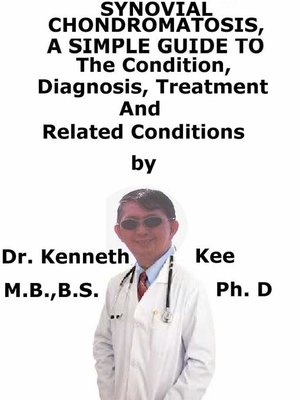Synovial Chondromatosis, a Simple Guide to the Condition, Diagnosis, Treatment and Related Conditions
ebook
By Kenneth Kee

Sign up to save your library
With an OverDrive account, you can save your favorite libraries for at-a-glance information about availability. Find out more about OverDrive accounts.
Find this title in Libby, the library reading app by OverDrive.



Search for a digital library with this title
Title found at these libraries:
| Library Name | Distance |
|---|---|
| Loading... |
This book describes Synovial Chondromatosis, Diagnosis and Treatment and Related Diseases
Synovial chondromatosis (termed synovial osteochondromatosis) is a rare, benign (non-cancerous) disorder that involves the synovium, which is the thin layer of tissue that lines the joints.
It is a proliferative disease of the synovium linked with cartilage metaplasia that leads to multiple intra-articular loose bodies and varies from synovial tissue to firm nodules of cartilage
Synovial chondromatosis can begin in any joint in the body, but most often happens in the knee.
While the disorder is not cancerous, it can seriously injure the affected joint and, eventually, cause osteoarthritis.
In synovial chondromatosis, the synovium develops abnormally and forms nodules made of cartilage.
These nodules can occasionally break off from the synovium and become loose inside the joint.
The size of the loose cartilage bodies inside the joint can range from a few millimeters (the size of a small pill) to a few centimeters (the size of a marble).
The synovial fluid nourishes the loose bodies and they may grow, calcify (harden), or ossify (turn into bone).
When this happens, they can move around freely inside the joint space.
As they move around, the loose bodies can injure the smooth articular cartilage that coats the joint, causing osteoarthritis.
In osteoarthritis, injured cartilage will be worn out and torn.
Moving the bones along this unprotected joint surface is painful.
In serious cases of synovial chondromatosis, the loose bodies may become large enough to occupy the complete joint space or penetrate into adjacent tissues.
Synovial chondromatosis most often happens in the knee, accompanied by the hip, elbow, and shoulder.
Cause
The disorder happens spontaneously.
Some research suggests that trauma may play a role in its development because the disorder primarily happens in weight-bearing joints.
Infection has also been indicated as a contributing factor.
Genetics may have a part to play.
Occasional chromosome 6 abnormalities have been found
The most frequent symptoms of synovial chondromatosis are the same as those of osteoarthritis.
There is a slow progression of symptoms.
These are:
1. Joint pain
2. Joint swelling
3. Pain worse with activity
4. Restricted range of motion in the involved joint
5. Mechanical symptoms including stiffness
6. A creaking, grinding, or popping noise during movement (crepitus)
The nodules can occasionally be felt in joints that are close to the skin, such as the knee, ankle, and elbow joints.
The nodules can happen in the bursa overlying an osteochondroma
Imaging studies will also help the doctor differentiate synovial chondromatosis from osteoarthritis.
Loose bodies can normally be seen on both MRI and CT scans.
Treatment
Early treatment is necessary to relieve painful symptoms and prevent further damage to the joint.
Non-surgical Treatment
Observation
Depending on the symptoms, simple observation can occasionally be a treatment method.
Indications for surgery are severe symptoms affecting range of motion of the joint.
The treatment for synovial chondromatosis normally requires surgery to remove the loose bodies of cartilage.
The synovium is also partly or fully removed (synovectomy) during surgery.
In an open surgical intervention, one or two incisions are done to remove a large amount of loose bodies from the joint.
In an arthroscopic procedure, the doctor will perform smaller incisions and utilize miniature surgical instruments to remove the loose...







